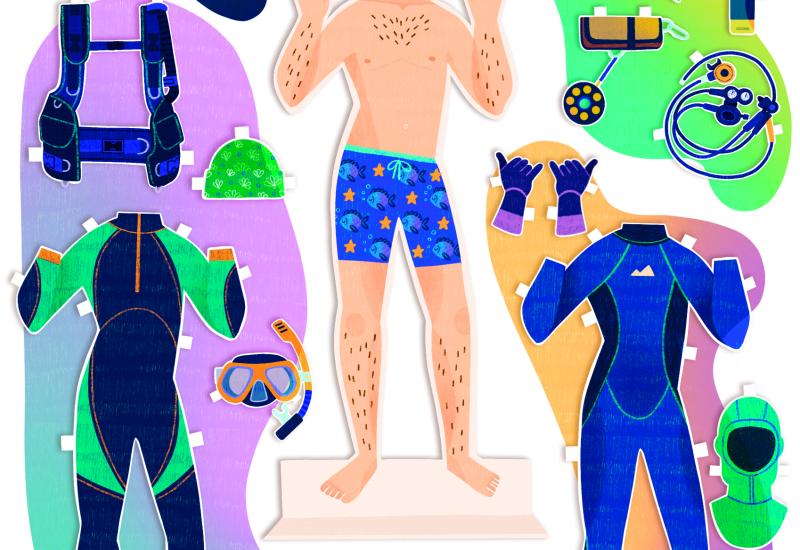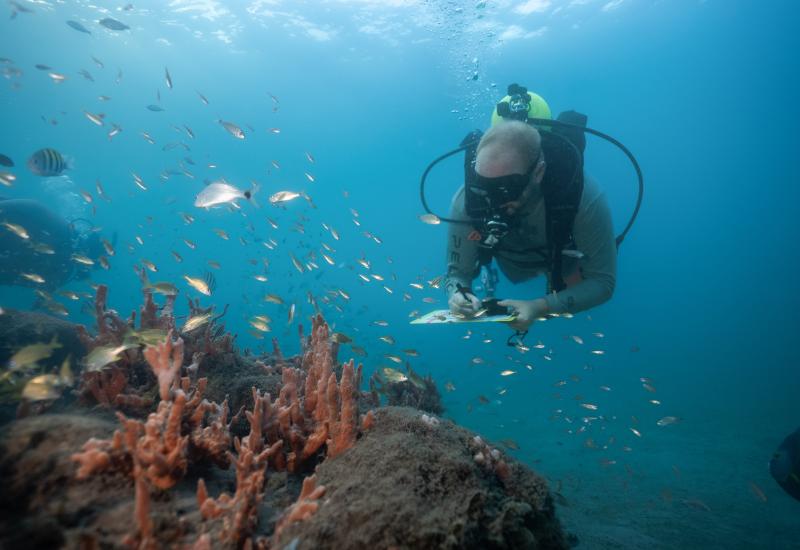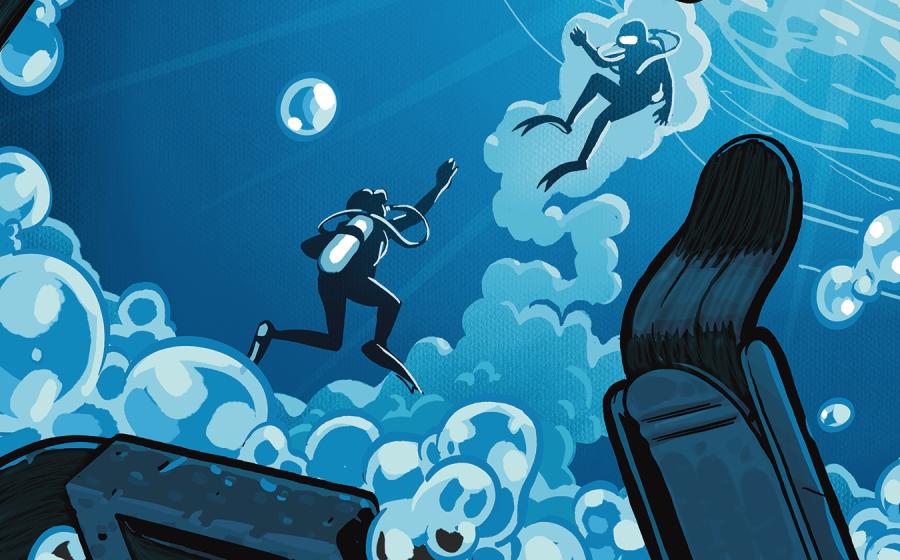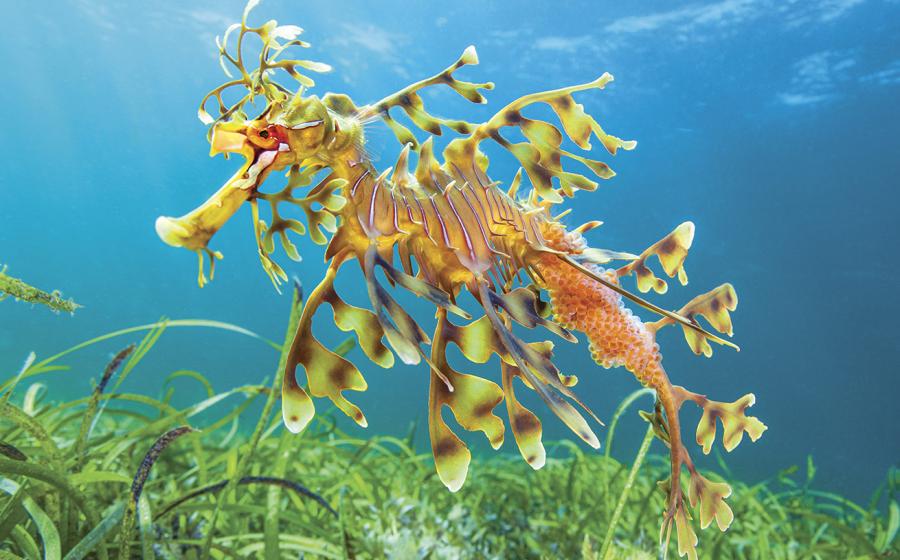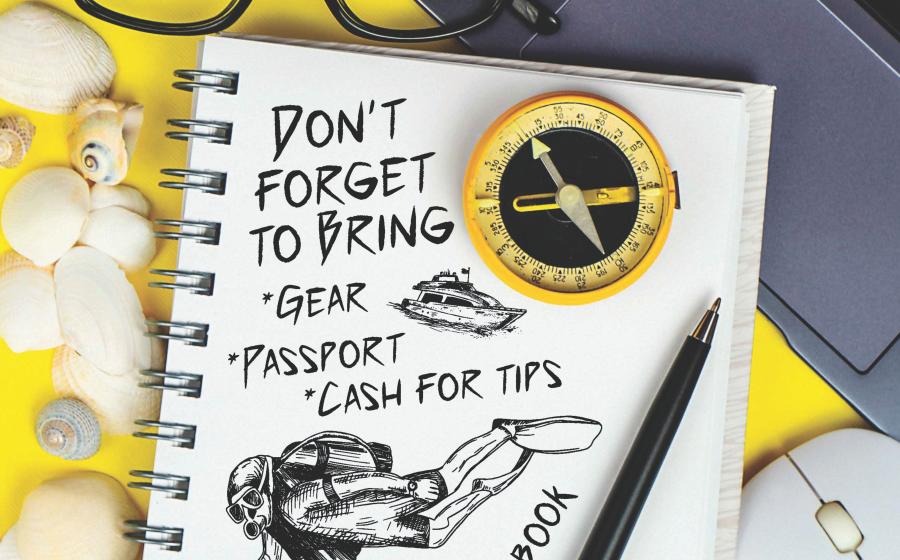Exit Strategy: Scuba Diving Decompression Explained

Scuba Diving Group Dive
Divers Photo from Shutterstock.com
Forget physics and physiology. If you want to understand decompression, head to Dodger Stadium.
Long ago, my dive buddy Ralph and I learned something about decompression by going to Dodger baseball games. After the last out, Ralph and I used to play our own game in the huge parking lot: how many of the thousands of cars could we beat to the freeway?
Dodger Stadium's parking lot is really a circulatory system. It's not one parking lot but many of different sizes. They are separated by barrier posts and linked by driveways to feeder roads. These roads join larger boulevards that eventually lead to exit routes. The design is meant to urge cars into smoothly flowing streams, but there are inevitable choke points that narrow the flow and back up traffic. When the Dodgers filled the stadium and the parking lot, as they did in those days, the design was overwhelmed by too many cars trying to fit into too little space, resulting in gridlock.
But Ralph and I could always find a way through or around the traffic jam because we had a decisive advantage — my 1964 VW Beetle. It could squeeze through gaps bigger cars couldn't. For example, the Bug could just fit between the bus bench and the light pole, which allowed us to jump the curb, cross the sidewalk, cut the corner and join moving traffic on a side street, leaving hundreds of the bigger cars stalled behind us.
Hit the Road
What does this have to do with decompression? The venous side of your body's circulatory system is designed like that parking lot, to optimize the flow of nitrogen, carbon dioxide and waste products to your lungs and liver — your on-ramps to the outside world. It has even more intersections and choke points than Dodger Stadium has driveways and barrier posts. It works fine in normal conditions, but it too can be overwhelmed when your tissues are saturated with nitrogen (like a sellout game) and you begin to ascend too fast (after the last out). If too much nitrogen crowds into your bloodstream at the same time, the resulting gridlock can cause painful and debilitating decompression sickness (DCS).
The real problem is bubbles, not molecules of nitrogen, just as at Dodger Stadium the problem is cars, not people. If you've ever sat in a postgame traffic jam and watched pedestrians stream past your stationary car, you saw that it's the bulky cars that jam things up. In fact, the fastest way to get from your seat to the outside edge of the parking lot is to walk.
Likewise, the fastest way for nitrogen to leave your body is as individual molecules dissolved in your flowing blood. But if too many molecules try to leave your tissues at once, they join up as bubbles — as if they climb into cars. The trouble is, your smaller capillaries are only five to 10 microns in diameter — a tenth the size of a human hair. In Dodger Stadium terms that's only turnstile-wide. Blood cells have to pass single file.
Individual molecules of dissolved nitrogen can flow through those capillaries, like pedestrians flow through turnstiles. The smallest bubbles, like baby strollers, can squeeze through too. (In fact, scientists have learned that all of us probably have some small bubbles in our bloodstreams all the time. They're sometimes called "silent bubbles" because they slip by harmlessly. They're a normal part of your bloodstream like a few baby strollers are a normal part of any pedestrian crowd.)
But bubbles can grow if the pressure of dissolved nitrogen around them is high enough. Now picture one of those slightly larger bubbles, say two fans trying to leave the Club House Level riding a golf cart. They come to the turnstile. Both could fit through it on foot, but as long as they stay on the golf cart neither can get through, nor can the hundreds of fans piling up behind them. In the same way, a bubble can completely fill a capillary, blocking further blood flow.
Why don't the fans abandon the golf cart? Maybe they will if it's only two of them facing an angry crowd. But if five or six more fans pile onto the cart and join forces with the first two, they may resist the crowd pressure and try to force the cart through. Likewise, when a bubble gets larger than a certain size, the gas molecules inside don't want to leave it. The bubble tends to get bigger easily and resist shrinking because the force of expansion (the gas pressure of the molecules inside the bubble) overwhelms the force of contraction (the bubble's surface tension). Instead of shrinking, the bubble grows as still more gas molecules pile into it.
The N2 SUV
Out in the parking lot, fans pile into cars of all sizes from my tiny VW Bug to Lincoln Navigator-size SUVs to, God help us, motor homes. The biggest ones take up more of the fixed amount of roadway and, as we've seen, do more to block the flow, while smaller cars like my VW find ways to slip by.
You might think larger vehicles, because they can carry more people, might "decompress" Dodger Stadium quicker. But the problem is, these are all-or-nothing packages. Until that Lincoln Navigator finds a hole big enough for its entire bulk, none of its four passengers gets through. But Ralph and I in our smaller package slip-slide down the middle of the two-lane access road and shoot onto the freeway trading high fives. The small car, like the small bubble, gets away faster.
Bubbles, too, are all-or-nothing packages. Because of surface tension, they act as if they had rubber skins. They don't easily break into smaller bubbles. Bubbles also tend to clump together and don't want to unclump. When bubbles reach a choke point in your circulatory system that they can't fit through, they tend to stop there and back up the blood flow.
Fortunately, the shape of a bubble is plastic. After it fills a capillary, it may extend down it sausage-shaped and eventually squirt past an obstruction. And your circulatory system has many alternate routes your blood can take. But serious, sustained blockages can happen when too many nitrogen molecules form into too many large bubbles because you tried to decompress too quickly.
The Postgame Riot
The resulting pain, tingling, numbness or paralysis are called decompression sickness (DCS). Bubbles are the cause, but no one is quite sure what they do. In one view, bubbles are basically foreign objects in your body. If bubbles block blood flow, your cells may be both starved of oxygen and poisoned by their own waste products. Growing bubbles may stretch and tear the walls of blood vessels or crush tissues. They may press on nerves.
Or bubbles may trigger your immune system to release leukocytes and platelets, whose job is to attack invaders. Powerful chemicals called the "complement cascade" may also be called into action as if the bubbles were bacteria. In this view, decompression sickness may be "collateral damage" resulting from your body's attack on bubbles, like the furniture that's broken while ejecting a intruder from your living room.
Or decompression sickness may be both things. Imagine Dodger Stadium the morning after the division playoffs: wrecked turnstiles, broken glass, skid marks, barrier poles bent by tow trucks, the bus bench taken down when the Navigator tried to follow my VW.
What to do about bubbles? Keep them small in the first place, of course, which is all about decompressing slowly so bubbles can leave your body before nitrogen molecules have a chance to crowd into them and make them big. A slow ascent rate with stops is the usual way. The safety stop at 15 feet is a lot like the seventh-inning stretch: fans who leave early take some of the pressure off the parking lot later.
But what if bubbles are too many and too big, gridlock has occurred and you're suffering decompression sickness? One "solution" is to wait it out. Most cases of mild, pain-only DCS will resolve in a few days with no treatment. Many bubbles eventually make their way to your lungs where they can be breathed out, just as that parking lot will eventually clear.
But that's risky. Some of the mild cases of DCS do not simply go away. The more serious the "hit," the more likely the damage is to be permanent without treatment. If you feel you may be bent, even slightly. call the Divers Alert Network emergency hotline at (919) 684-4326. They will refer you to a local doctor familiar with decompression sickness and, if called for, to a recompression chamber for treatment.
THE Amazing Shrinking Ray
Recompression therapy has been recognized as the best treatment for DCS since the construction of the Hudson River Tunnel in 1909, where recompression reduced the percentage of bent workers with permanent disability from almost 14 percent to less than 1 percent. The idea is to put the diver or caisson worker under pressure again in order to compress bubbles so they can slip by obstructions. Then, you can gradually reduce the pressure as bubbles and nitrogen leave his body.
Imagine, for example, an Amazing Shrinking Ray out of 1950s science fiction mounted on top of the Dodger Stadium scoreboard. (Stay with me here.) It's trained on the gridlocked parking lot, and simultaneously reduces all the cars to half their normal size. Now four cars fit into two lanes, some of them slip between barrier posts and even the Navigator can ease by the bus bench. The parking lot clears much quicker with less damage. As cars leave, the shrinking ray can be gradually turned off.
Recompression also slows down the rush of nitrogen from your tissues to your bloodstream because it reduces the pressure difference, or gradient, between tissues, blood and lungs. That allows more of the nitrogen, both dissolved and in small bubbles, to flow freely and escape instead of ganging up into bigger bubbles. With a smaller pressure gradient, nitrogen molecules are, in a sense, less eager to leave your tissues, so the analogy might be to a postgame show that holds at least some of the fans in their seats for a while.
When recompression squeezes bubbles small enough, their surface tension overwhelms their internal pressure and they continue to shrink on their own. Nitrogen molecules are forced out of these bubbles. Now, as individuals, they can move more freely between the cells of your tissues and make their way down your bloodstream. In the same way, that shrinking ray is going to make some of those cars uncomfortably crowded, and some passengers will get out and walk.
And that, basically, is how recompression treatment untangles the traffic jam of bubbles that we call decompression sickness. It's no different from clearing a jam-packed parking lot — if only the Dodgers had that Amazing Shrinking Ray.
Opening The "Oxygen Window"
But it's not quite the whole story. There's one problem with simply recompressing the bent diver. For every breath he exhales in a recompression chamber, he inhales another. If he's inhaling air, 79 percent of it is nitrogen under pressure, which he certainly doesn't need more of. Assuming the pressure in the chamber is less than the pressure in his tissues, he will still off-gas nitrogen, but it will take longer. A lot longer.
For example, one early recompression treatment schedule using air only, the U.S. Navy Table 4, required over 37 hours to complete. It didn't always cure DCS in the patient and sometimes caused it in the tender who accompanied him in the chamber. And both had trouble with nitrogen narcosis.
The obvious solution is not to breathe any nitrogen in the chamber, to breathe pure oxygen. That way, the pressure of nitrogen leaving your body does not compete with the pressure of nitrogen entering, and you off-gas faster. And because your body uses some of the oxygen you breathe in, you don't exhale as much total gas as you inhale. The "vacant" space in an exhaled breath, called the "oxygen window," can be taken up by more nitrogen, which now leaves the body still faster. Oxygen also helps your body repair tissue damage, like that caused by bubbles.
For all those reasons, the best first aid for DCS is to breathe oxygen as soon as you can for as long as you can, until you get to a recompression chamber. In the chamber, while you are recompressed, you'll continue to breathe oxygen.
Dodger Stadium can explain the oxygen window, too. Imagine that fans have to call taxis to leave the stadium, and that the cabs arrive already containing passengers. Those taxis are like inhaled breaths of air, each containing nitrogen. Assuming a fan or two can crowd into each taxi, Dodger Stadium will eventually empty, but it may take as long as Navy Table 4 on air.
If we could arrange for taxis to arrive with no passengers, each could leave with three or four fans instead of one or two, and the stadium would empty faster. Even better, what if the driver got out, making room for a fifth fan to drive the taxi away? That "driver window" would help even more, especially if the driver goes to work repairing the damage caused by the crowd.
So you want to breathe oxygen in the recompression chamber. But it's not that simple. Breathing too much oxygen for too long is dangerous. Oxygen toxicity can attack both your lungs and your central nervous system. Both the pressure and the concentration of oxygen combine to make a toxic dose over time, and the dose you need in a recompression chamber to treat DCS is high: 100 percent oxygen at 6o feet (the treatment "depth" for Navy Table 6) means an oxygen pressure of z.8 atmospheres — nearly twice the limit considered safe for nitrox diving.
That's why if you're ever treated in a recompression chamber you'll breathe oxygen through a mask or a tent for, say, 20 minutes, followed by five minutes breathing air, then 20 minutes on oxygen again, five minutes on air and so on. This oxygen/air cycle can be repeated as many as five times at 6o feet and 18 times at 30 feet before pulmonary oxygen toxicity becomes likely. (One more time: suppose those dismounted taxi drivers get rowdy, gang up and vandalize the stadium? Better keep them separated in small groups, small "doses.")
This multipronged attack on bubbles — compressing them, slowing their growth, denying them more nitrogen and treating the damage they cause with oxygen — has reduced chamber treatment times from a day and a half to four hours, 45 minutes, for the U.S. Navy Table 6 used in the vast majority of recompression treatments. Mild cases of DCS can be resolved even sooner with Table 5, only two hours, 15 minutes.
With modern recompression therapy, the probability of a complete recovery is much greater too. According to the latest statistics from DAN, recompression therapy "cured" 71 percent of all DCS cases immediately, and within 12 months all but two percent of patients had no symptoms.
I can't promise such a dramatic recovery from parking lot gridlock, but in both cases, size matters and small is beautiful.
Find more scuba diving training tips, advice and explanations by visiting the Dive Training section of our website.

Divers Photo from Shutterstock.comWe divers can forget dive theory content — maybe it's time to brush up on your knowledge skills.
Forget physics and physiology. If you want to understand decompression, head to Dodger Stadium.
Long ago, my dive buddy Ralph and I learned something about decompression by going to Dodger baseball games. After the last out, Ralph and I used to play our own game in the huge parking lot: how many of the thousands of cars could we beat to the freeway?
Dodger Stadium's parking lot is really a circulatory system. It's not one parking lot but many of different sizes. They are separated by barrier posts and linked by driveways to feeder roads. These roads join larger boulevards that eventually lead to exit routes. The design is meant to urge cars into smoothly flowing streams, but there are inevitable choke points that narrow the flow and back up traffic. When the Dodgers filled the stadium and the parking lot, as they did in those days, the design was overwhelmed by too many cars trying to fit into too little space, resulting in gridlock.
But Ralph and I could always find a way through or around the traffic jam because we had a decisive advantage — my 1964 VW Beetle. It could squeeze through gaps bigger cars couldn't. For example, the Bug could just fit between the bus bench and the light pole, which allowed us to jump the curb, cross the sidewalk, cut the corner and join moving traffic on a side street, leaving hundreds of the bigger cars stalled behind us.
Hit the Road
What does this have to do with decompression? The venous side of your body's circulatory system is designed like that parking lot, to optimize the flow of nitrogen, carbon dioxide and waste products to your lungs and liver — your on-ramps to the outside world. It has even more intersections and choke points than Dodger Stadium has driveways and barrier posts. It works fine in normal conditions, but it too can be overwhelmed when your tissues are saturated with nitrogen (like a sellout game) and you begin to ascend too fast (after the last out). If too much nitrogen crowds into your bloodstream at the same time, the resulting gridlock can cause painful and debilitating decompression sickness (DCS).
The real problem is bubbles, not molecules of nitrogen, just as at Dodger Stadium the problem is cars, not people. If you've ever sat in a postgame traffic jam and watched pedestrians stream past your stationary car, you saw that it's the bulky cars that jam things up. In fact, the fastest way to get from your seat to the outside edge of the parking lot is to walk.
Likewise, the fastest way for nitrogen to leave your body is as individual molecules dissolved in your flowing blood. But if too many molecules try to leave your tissues at once, they join up as bubbles — as if they climb into cars. The trouble is, your smaller capillaries are only five to 10 microns in diameter — a tenth the size of a human hair. In Dodger Stadium terms that's only turnstile-wide. Blood cells have to pass single file.
Individual molecules of dissolved nitrogen can flow through those capillaries, like pedestrians flow through turnstiles. The smallest bubbles, like baby strollers, can squeeze through too. (In fact, scientists have learned that all of us probably have some small bubbles in our bloodstreams all the time. They're sometimes called "silent bubbles" because they slip by harmlessly. They're a normal part of your bloodstream like a few baby strollers are a normal part of any pedestrian crowd.)
But bubbles can grow if the pressure of dissolved nitrogen around them is high enough. Now picture one of those slightly larger bubbles, say two fans trying to leave the Club House Level riding a golf cart. They come to the turnstile. Both could fit through it on foot, but as long as they stay on the golf cart neither can get through, nor can the hundreds of fans piling up behind them. In the same way, a bubble can completely fill a capillary, blocking further blood flow.
Why don't the fans abandon the golf cart? Maybe they will if it's only two of them facing an angry crowd. But if five or six more fans pile onto the cart and join forces with the first two, they may resist the crowd pressure and try to force the cart through. Likewise, when a bubble gets larger than a certain size, the gas molecules inside don't want to leave it. The bubble tends to get bigger easily and resist shrinking because the force of expansion (the gas pressure of the molecules inside the bubble) overwhelms the force of contraction (the bubble's surface tension). Instead of shrinking, the bubble grows as still more gas molecules pile into it.
WANT TO LEARN MORE? SIGN UP FOR PADI'S ONLINE DIVE THEORY COURSE TODAY!
The N2 SUV
Out in the parking lot, fans pile into cars of all sizes from my tiny VW Bug to Lincoln Navigator-size SUVs to, God help us, motor homes. The biggest ones take up more of the fixed amount of roadway and, as we've seen, do more to block the flow, while smaller cars like my VW find ways to slip by.
You might think larger vehicles, because they can carry more people, might "decompress" Dodger Stadium quicker. But the problem is, these are all-or-nothing packages. Until that Lincoln Navigator finds a hole big enough for its entire bulk, none of its four passengers gets through. But Ralph and I in our smaller package slip-slide down the middle of the two-lane access road and shoot onto the freeway trading high fives. The small car, like the small bubble, gets away faster.
Bubbles, too, are all-or-nothing packages. Because of surface tension, they act as if they had rubber skins. They don't easily break into smaller bubbles. Bubbles also tend to clump together and don't want to unclump. When bubbles reach a choke point in your circulatory system that they can't fit through, they tend to stop there and back up the blood flow.
Fortunately, the shape of a bubble is elastic. After it fills a capillary, it may extend down it sausage-shaped and eventually squirt past an obstruction. And your circulatory system has many alternate routes your blood can take. But serious, sustained blockages can happen when too many nitrogen molecules form into too many large bubbles because you tried to decompress too quickly.
The Postgame Riot
The resulting pain, tingling, numbness or paralysis are called decompression sickness (DCS). Bubbles are the cause, but no one is quite sure what they do. In one view, bubbles are basically foreign objects in your body. If bubbles block blood flow, your cells may be both starved of oxygen and poisoned by their own waste products. Growing bubbles may stretch and tear the walls of blood vessels or crush tissues. They may press on nerves.
Or bubbles may trigger your immune system to release leukocytes and platelets, whose job is to attack invaders. Powerful chemicals called the "complement cascade" may also be called into action as if the bubbles were bacteria. In this view, decompression sickness may be "collateral damage" resulting from your body's attack on bubbles, like the furniture that's broken while ejecting a intruder from your living room.
Or decompression sickness may be both things. Imagine Dodger Stadium the morning after the division playoffs: wrecked turnstiles, broken glass, skid marks, barrier poles bent by tow trucks, the bus bench taken down when the Navigator tried to follow my VW.
What to do about bubbles? Keep them small in the first place, of course, which is all about decompressing slowly so bubbles can leave your body before nitrogen molecules have a chance to crowd into them and make them big. A slow ascent rate with stops is the usual way. The safety stop at 15 feet is a lot like the seventh-inning stretch: fans who leave early take some of the pressure off the parking lot later.
But what if bubbles are too many and too big, gridlock has occurred and you're suffering decompression sickness? One "solution" is to wait it out. Most cases of mild, pain-only DCS will resolve in a few days with no treatment. Many bubbles eventually make their way to your lungs where they can be breathed out, just as that parking lot will eventually clear.
But that's risky. Some of the mild cases of DCS do not simply go away. The more serious the "hit," the more likely the damage is to be permanent without treatment. If you feel you may be bent, even slightly. call the Divers Alert Network emergency hotline at (919) 684-4326. They will refer you to a local doctor familiar with decompression sickness and, if called for, to a recompression chamber for treatment.
THE Amazing Shrinking Ray
Recompression therapy has been recognized as the best treatment for DCS since the construction of the Hudson River Tunnel in 1909, where recompression reduced the percentage of bent workers with permanent disability from almost 14 percent to less than 1 percent. The idea is to put the diver or caisson worker under pressure again in order to compress bubbles so they can slip by obstructions. Then, you can gradually reduce the pressure as bubbles and nitrogen leave his body.
Imagine, for example, an Amazing Shrinking Ray out of 1950s science fiction mounted on top of the Dodger Stadium scoreboard. (Stay with me here.) It's trained on the gridlocked parking lot, and simultaneously reduces all the cars to half their normal size. Now four cars fit into two lanes, some of them slip between barrier posts and even the Navigator can ease by the bus bench. The parking lot clears much quicker with less damage. As cars leave, the shrinking ray can be gradually turned off.
Recompression also slows down the rush of nitrogen from your tissues to your bloodstream because it reduces the pressure difference, or gradient, between tissues, blood and lungs. That allows more of the nitrogen, both dissolved and in small bubbles, to flow freely and escape instead of ganging up into bigger bubbles. With a smaller pressure gradient, nitrogen molecules are, in a sense, less eager to leave your tissues, so the analogy might be to a postgame show that holds at least some of the fans in their seats for a while.
When recompression squeezes bubbles small enough, their surface tension overwhelms their internal pressure and they continue to shrink on their own. Nitrogen molecules are forced out of these bubbles. Now, as individuals, they can move more freely between the cells of your tissues and make their way down your bloodstream. In the same way, that shrinking ray is going to make some of those cars uncomfortably crowded, and some passengers will get out and walk.
And that, basically, is how recompression treatment untangles the traffic jam of bubbles that we call decompression sickness. It's no different from clearing a jam-packed parking lot — if only the Dodgers had that Amazing Shrinking Ray.
Opening The "Oxygen Window"
But it's not quite the whole story. There's one problem with simply recompressing the bent diver. For every breath he exhales in a recompression chamber, he inhales another. If he's inhaling air, 79 percent of it is nitrogen under pressure, which he certainly doesn't need more of. Assuming the pressure in the chamber is less than the pressure in his tissues, he will still off-gas nitrogen, but it will take longer. A lot longer.
For example, one early recompression treatment schedule using air only, the U.S. Navy Table 4, required over 37 hours to complete. It didn't always cure DCS in the patient and sometimes caused it in the tender who accompanied him in the chamber. And both had trouble with nitrogen narcosis.
The obvious solution is not to breathe any nitrogen in the chamber, to breathe pure oxygen. That way, the pressure of nitrogen leaving your body does not compete with the pressure of nitrogen entering, and you off-gas faster. And because your body uses some of the oxygen you breathe in, you don't exhale as much total gas as you inhale. The "vacant" space in an exhaled breath, called the "oxygen window," can be taken up by more nitrogen, which now leaves the body still faster. Oxygen also helps your body repair tissue damage, like that caused by bubbles.
For all those reasons, the best first aid for DCS is to breathe oxygen as soon as you can for as long as you can, until you get to a recompression chamber. In the chamber, while you are recompressed, you'll continue to breathe oxygen.
Dodger Stadium can explain the oxygen window, too. Imagine that fans have to call taxis to leave the stadium, and that the cabs arrive already containing passengers. Those taxis are like inhaled breaths of air, each containing nitrogen. Assuming a fan or two can crowd into each taxi, Dodger Stadium will eventually empty, but it may take as long as Navy Table 4 on air.
If we could arrange for taxis to arrive with no passengers, each could leave with three or four fans instead of one or two, and the stadium would empty faster. Even better, what if the driver got out, making room for a fifth fan to drive the taxi away? That "driver window" would help even more, especially if the driver goes to work repairing the damage caused by the crowd.
So you want to breathe oxygen in the recompression chamber. But it's not that simple. Breathing too much oxygen for too long is dangerous. Oxygen toxicity can attack both your lungs and your central nervous system. Both the pressure and the concentration of oxygen combine to make a toxic dose over time, and the dose you need in a recompression chamber to treat DCS is high: 100 percent oxygen at 6o feet (the treatment "depth" for Navy Table 6) means an oxygen pressure of z.8 atmospheres — nearly twice the limit considered safe for nitrox diving.
That's why if you're ever treated in a recompression chamber you'll breathe oxygen through a mask or a tent for, say, 20 minutes, followed by five minutes breathing air, then 20 minutes on oxygen again, five minutes on air and so on. This oxygen/air cycle can be repeated as many as five times at 6o feet and 18 times at 30 feet before pulmonary oxygen toxicity becomes likely. (One more time: suppose those dismounted taxi drivers get rowdy, gang up and vandalize the stadium? Better keep them separated in small groups, small "doses.")
This multipronged attack on bubbles — compressing them, slowing their growth, denying them more nitrogen and treating the damage they cause with oxygen — has reduced chamber treatment times from a day and a half to four hours, 45 minutes, for the U.S. Navy Table 6 used in the vast majority of recompression treatments. Mild cases of DCS can be resolved even sooner with Table 5, only two hours, 15 minutes.
With modern recompression therapy, the probability of a complete recovery is much greater too. According to the latest statistics from DAN, recompression therapy "cured" 71 percent of all DCS cases immediately, and within 12 months all but two percent of patients had no symptoms.
I can't promise such a dramatic recovery from parking lot gridlock, but in both cases, size matters and small is beautiful.
Find more scuba diving training tips, advice and explanations by visiting the Dive Training section of our website.


